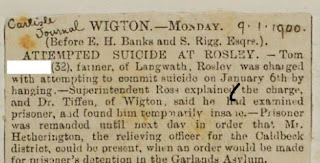As a follow on from my last post, I would like to share some photographs from the Time to Change event in Carlisle on World Mental Health Day 2017. A huge thank you to Caroline Robinson for creating such an amazing display and providing the pictures! Some of the Garlands records were digitised and transcribed for visitors to see how mental illness was regarded and treated in the late nineteenth century. Alongside this was also some detail surrounding the context of the records, most notably the 1890 Lunacy Act.
Central to the display were two patient records from the 1890s and 1900s. The first, Tom M, was admitted to Garlands in September 1900 suffering from mania caused by his intemperate habits. What was interesting about Tom's case, is that a newspaper article was attached to his case notes denoting his attempt to take his own life prior to admission:
Clippings from newspapers relating to the patient and their condition were often attached to the case notes during this period. Anything to assist the doctors in creating a picture of their behaviour prior to admission was considered valuable in keeping with their medical records. On admission, Tom seemed to be somewhat confused and could not recall attempting to hang himself: “Patient
has a childish vacant expression: Did not know why he was in custody: On being
asked why he had attempted to finish himself in that way, he replied ‘What
way?’ He has been drinking heavily for a long time and attempted to hang
himself. There is no one to take charge of him and in his present condition is
not fit to be at large.” It seemed that some time away from his surroundings, and the temptation of alcohol, was enough to fully recover Tom, as one month after admission he was discharged as recovered and never returned for treatment in Garlands.
The second case displayed was that of James G, who was admitted to Garlands in September 1898 also suffering from mania. James was brought to Garlands with little known about him, as he had been found wandering at large: 'Been curious in behaviour and frightening people in district'. He seemed to be very confused at the beginning of treatment as to where he had come from and what had occurred prior to admission. What is most interesting to note from his case notes is that he displayed a desire to remain in the asylum. For instance on 2 October 1898, the doctors noted: "says he is quite content to remain
here." Similarly on 2 November 1898: "Says he likes better being up here
because there are books here." However, once James began to recover, his desire to return home became clear. Eleven months after admission it was noted: “Rather
unsettled and restless. Very
anxious to go home or he says he wants a change.” James was discharged recovered in September 1899, and, like Tom above, never returned to Garlands.
These two patient stories are a snippet of the research I have been conducting for my PhD thesis on the history of the Garlands Asylum. The full launch of the Garlands Project will be on 8 November, where I, among many others, shall be giving a talk detailing the history of this fascinating institution. If you would like to attend, please see the below picture. It is also expected for there to be an ongoing exhibition from the event which will be toured around the county, details to follow.










